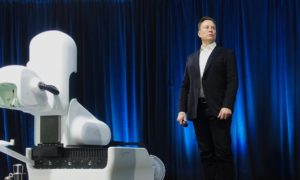World: Futurist and inventor Elon Musk on Friday unveiled ambitious plans to send cargo ships to Mars in five years and use rockets to carry people between Earth’s major cities in under half an hour.
The founder of SpaceX said a planned interplanetary transport system, codenamed BFR (Big F**king Rocket), would be downsized so it could carry out a range of tasks that would then pay for future Mars missions.
“The most important thing…is that I think we have figured out how to pay for (BFR),” Musk told a packed auditorium at a global gathering of space experts in Adelaide.
BFR is capable of transporting satellites to orbit, crew and cargo to the @Space_Station and completing missions to the Moon and Mars. pic.twitter.com/p9staho4VZ
— SpaceX (@SpaceX) September 29, 2017
“Which is to have a smaller vehicle, it’s still pretty big, but one that can…do everything that’s needed in the greater Earth orbit activity.”
Musk said his firm had starting building the system, with the construction of the first ship to start in six to nine months. “I feel fairly confident that we can complete the ship and launch in about five years,” he said.
At least two cargo ships would land on the Red Planet in 2022, with the key mission of finding the best source of water – currently mooted as a way to power rockets, he said.
The rockets would place power, mining and life-support infrastructure on Mars to support future missions, with four ships set to take people, equipment and supplies to the planet in 2024.
Supporting the creation of a permanent, self-sustaining human presence on Mars. https://t.co/kCtBLPbSg8 pic.twitter.com/ra6hKsrOcG
— SpaceX (@SpaceX) September 29, 2017
NASA’s first human mission to Mars is expected about a decade later.
The trips would be funded by a range of activities, including launching satellites, servicing the space station and lunar missions, he said.
Musk added the rockets should also cater to Earth inhabitants by reducing the travel between major cities to less than half an hour. A trip from Bangkok to Dubai would take 27 minutes, and from Tokyo to Delhi 30 minutes, according to his calculations.
“Once you are out of the atmosphere, it would be as smooth as silk, no turbulence, nothing,” he said. “There’s no weather…and you can get to most long-distance places in less than half-an-hour. If we are building this thing to go to the Moon and Mars, then why not go to other places on Earth as well.”
Musk had earlier planned to use a suite of space vehicles to support the colonisation of Mars, beginning with an unmanned capsule called Red Dragon in 2018, but he said SpaceX is now focused on a single, slimmer and shorter rocket instead.
Fly to most places on Earth in under 30 mins and anywhere in under 60. Cost per seat should be… https://t.co/dGYDdGttYd
— Elon Musk (@elonmusk) September 29, 2017
“We want to make our current vehicles redundant,” he said. “We want to have one system. If we can do that, then all the resources…can be applied to this system. I feel fairly confident that we can complete the ship and be ready for a launch in about five years.”
The BFR would be partially reusable and capable of flight directly from Earth to Mars with around 100 passengers, Musk said.
The week-long annual International Astronautical Congress, which concluded on Friday, has seen government space agencies and private firms outline their plans to send humans to the Moon and Mars in the next few decades.
This included an agreement between Russian space agency Roscosmos and NASA to work on the first lunar space station as part of a programme called the Deep Space Gateway.
Lockheed Martin Corp announced separate plans for a manned Mars journey on Friday, unveiling concept drawings of a “base camp” space station orbiting Mars and landing craft that would carry four astronauts to the planet’s surface.
“We know it’s cold, it’s pretty inhospitable, so we start with the robots and then we go down with these landers,” Rob Chambers, Lockheed’s director of human space flight strategy, told Australian Broadcasting Corporation.
Chambers gave no date, but the planned mission would be a joint expedition with NASA, which aims to reach Mars during the 2030s.
Mars is typically 225 million km from Earth and landing the first humans there, after what traditionally has been seen as a six- to nine-month journey, is an extremely ambitious goal.
Amazon.com founder Jeff Bezos’ Blue Origin space venture is also designing a heavy-lift vehicle called New Armstrong that will be capable of Mars transport.












